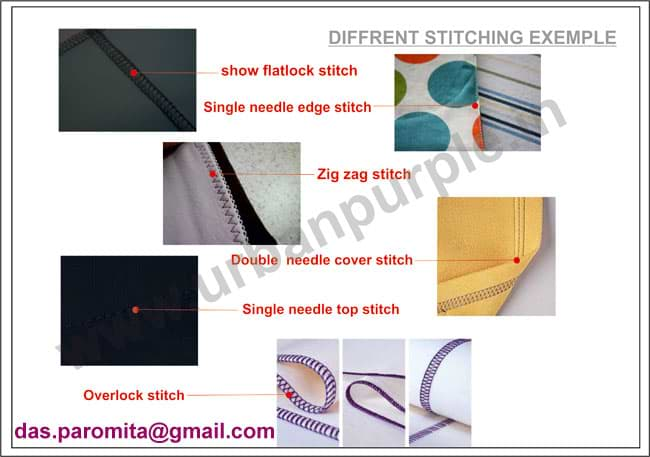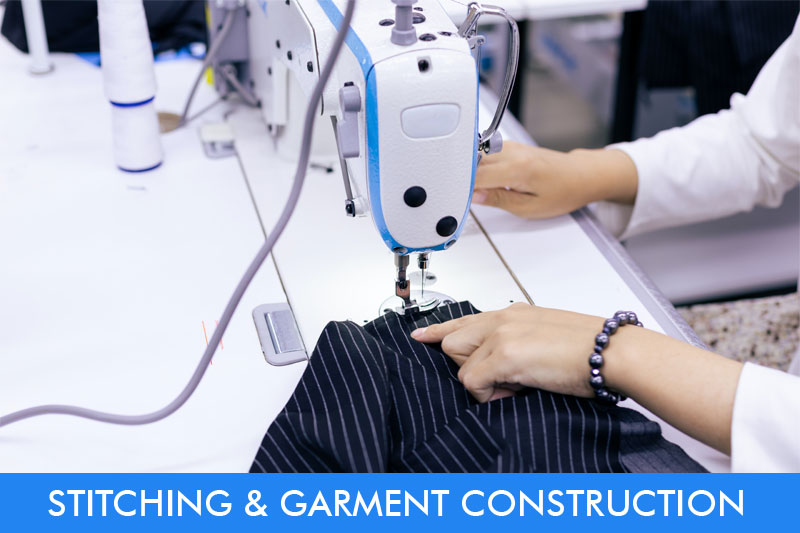Stitching and Garment Construction Detailing on Apparel Tech Pack
The stitching and garment construction significantly impact the final appearance of a garment. Achieving an accurate fit relies heavily on the quality of stitching and construction. These details play a significant role in the tech pack, as they determine the fit and durability of the garment. The stitching and construction instructions must be clear and precise. The tech pack designer’s expertise is crucial in effectively conveying this information. The factory follows these instructions to process the batch, and the order of sewing machines and operators can significantly impact production capacity and output quality. Having a well-planned and detailed approach can make a significant difference in the overall outcome.
Below are the three standard stitching methods. In addition, manufacturers use various other sophisticated machines in the garment manufacturing. So, a tech pack designer must know the methods of stitching to plan the stitching and construction details. The job of a tech pack designer is to mention the correct stitching and garment construction details to prepare the style. Only designers having grassroots-level experience in a factory environment can explain them in a tech pack. Those methods are commonly used in ready-to-wear fashion collection production. However, it can be applied to any custom clothing or designer garment production.
Essential Components in Stitching and Garment Construction Detailing
1. Seams: Seams are the most common type of stitching used to join fabric panels together. There are various seams, including plain seams, French seams, flat-felled seams, and overlock seams. The choice of seam depends on the fabric type, garment style, and desired aesthetic.
2. Hems: Designers use hems to finish a garment’s edges. Common types of hems include single-fold hems, double-fold hems, blind hems, and rolled hems. The choice of the hem depends on the fabric weight, garment style, and desired finish.
3. Darts: Darts are stitching details used to shape fabric and create a fitted silhouette. Garments such as dresses, skirts, and pants commonly use darts. Designers can choose between tapered or straight darts, and the placement and size of these darts are crucial for achieving the desired fit.
4. Pleats: Designers use pleats to create volume or shape in garments by stitching folds of fabric. Pleats are commonly used in skirts, dresses, and sleeves. The depth and direction of pleats are important considerations for achieving the desired aesthetic and functionality.
5. Collars and Cuffs: Collars and cuffs require specific stitching techniques to ensure proper shaping and durability. Designers commonly use topstitching to secure collars and cuffs while adding decorative detailing to garments.
6. Zippers and Fastenings: Zippers and other fastenings require precise stitching techniques to ensure proper functionality and secure attachment. Designers often utilize topstitching and reinforcement stitching to strengthen these areas in garments.
7. Pockets: Designers can use various techniques, such as patch pockets, welt pockets, or inseam pockets, to stitch pockets onto garments. The stitching should be secure and aligned properly to maintain the pockets’ integrity and functionality.
These are just a few examples of stitching and garment construction details that are important to consider in a tech pack. The specific stitching techniques and construction methods may vary depending on the garment’s style and design. Providing clear and detailed instructions for each stitching detail is crucial for achieving the desired outcome.
Overlock Stitch ( Sergers Stitch ), Famously Known as Cover Stitching
Overlock stitching, also known as serging, is a crucial process used in garment construction. It is a common practice to use it for edging and seaming fabric pieces together, as it provides a clean finish and prevents fraying. Here are some critical points about overlock stitching:
1. Purpose: The primary purpose of overlock stitching is to protect the fabric edges from unraveling or fraying. By enclosing the raw edges with multiple threads, overlock stitching enhances the durability and longevity of the garment.
2. Fabric Compatibility: Overlock stitching suits woven and knitted fabrics. It is crucial for knit fabrics that tend to unravel due to their structure.
3. Machine Varieties: Overlock sewing machines come in various configurations, offering different numbers of threads. The most common types are 3-thread and 4-thread overlock machines. Some advanced machines also provide a 5-thread option. The machine and thread configuration choice depends on the desired finish and fabric type.
4. Stitch Formation: Overlock stitching typically creates a stitch that wraps around the fabric edge, securing it with multiple threads. Stitching involves trimming excess fabric, enclosing the edge with threads, and simultaneously stitching and serging the fabric layers.
5. Seam Finishes: Designers can use overlock stitching to finish seam edges, creating a neat and professional appearance on the inside and outside of the garment. This technique proves particularly useful when the seams are visible or when a clean finish is desired.
6. Stretch and Flexibility: Overlock stitching provides a degree of stretch and flexibility to the seams, making it suitable for garments that require ease of movement or have stretchy fabric compositions.
Overall, overlock stitching is an essential technique in garment construction to ensure the product’s durability, longevity, and professional finish. Clear instructions for overlock stitching in the tech pack are crucial to achieve the desired result during manufacturing.
Single Needle Stitching ( Lock Stitch In Singer )
Garment manufacturing units widely use single-needle machines, particularly for stitching woven garments. Here are some critical points about single-needle stitching:
1. Machine Type: Single-needle or lockstitch machines are the most commonly used sewing machines in the apparel industry. They use a single needle to create a lockstitch, which consists of an upper thread and a bobbin thread interlocking within the fabric layers.
2. Suitable for Woven Fabrics: Single-needle stitching is particularly suitable for woven fabrics such as shirts, trousers, dresses, and denim. These fabrics are usually less stretchy and more rigid, making them compatible with the straight stitch produced by single-needle machines.
3. Stitch Formation: Single-needle machines create a strong and secure stitch by passing the needle through the fabric layers and interlocking the upper thread with the bobbin thread. This lockstitch is known for its durability and resistance to unraveling.
4. Versatility: Single-needle machines offer versatility in stitch length, tension, and other settings, allowing operators to adjust the stitching according to the fabric type and desired outcome. This versatility enables garment manufacturers to produce various styles and designs.
5. Precision and Control: Single-needle machines precisely control the stitching process, allowing operators to achieve accurate seam lines, topstitching, and other decorative details. This makes them suitable for creating clean and professional finishes on garments.
6. Commonly Seen on Labels: Dress shirt labels or garment tags often mention the term “single needle stitching” to indicate the use of lockstitch machines. This assures customers that the garment has been constructed using a reliable and durable stitching method.
Single-needle stitching is an essential technique in garment manufacturing, especially for woven garments. The tech pack should provide clear instructions for single-needle stitching, specifying the stitch length, seam allowances, and any other relevant details to ensure consistency and quality during production.
Flatlock Stitching
Flatlock stitching is commonly used in jersey and stretchable fabrics. Most T-shirt manufacturers use this machine for bottom hem stitching. Here are some critical points about flatlock stitching:
1. Suitable for Stretchable Fabrics: Flatlock stitching is ideal for sewing knitwear and stretchable fabrics, including jerseys, activewear, swimwear, and other garments that require stretch and flexibility. It allows the seams to expand and contract with the fabric without breaking or causing discomfort.
2. Strong and Flexible Seam: The flatlock stitch creates a strong and flexible seam that can withstand the stretching and movement of the fabric. Designers purposefully design it to provide durability and comfort, making it suitable for sportswear and other active apparel.
3. Appearance: Flatlock stitching creates a flat seam with the same appearance on both sides of the fabric. This is achieved by overlapping the fabric layers and stitching them together with multiple threads. The resulting stitch often resembles a ladder-like pattern on the outside of the garment.
4. Stretchability: One key advantage of flatlock stitching is its ability to maintain the fabric’s stretchability. Unlike other stitches that may restrict the fabric’s stretch, flatlock stitching allows the garment to retain its elasticity and conform to the body’s movements.
5. Decorative and Functional: Flatlock stitching serves a functional purpose and allows designers to use it as a decorative element in garment design. Designers can achieve this by employing matching or contrasting threads, which enhance the visual appeal of the seams and create a distinct aesthetic.
6. Use of Specialized Machines: Flatlock stitching requires specialized machines. We generally refer to those machines as flatlock machines equipped with multiple needles and loopers. These machines are specifically designed to create the flatlock stitch efficiently and accurately.
When including flatlock stitching in the tech pack, clear instructions on the stitch formation, thread color, and any specific details regarding the placement and width of the flatlock seams are essential. This ensures that the desired look and functionality are achieved during garment production.
Advantages of Working With Fashion Studio Urban Purple
Urban Purple is a team of fashion designers and consultants specializing in technology. In addition, we operate an online store where you can download fashion tech packs, graphics, and textile prints. You can get a complete tech pack and spec sheet from our tech pack template store. Our store offers a wide selection of fashion tech packs for you to choose from. All our tech packs have been thoroughly tested in factory environments. This means you can confidently select your preferred styles and easily make your purchase. You’ll receive a garment measurement spec sheet when you download our apparel tech pack template. Additionally, we provide the tech pack’s source vector file and the spec sheet in Excel format.
I greatly appreciate my readers’ support in promoting my blog. Sharing this post with your network would be immensely helpful in spreading the word about my content. By doing so, you’ll enable me to continue creating valuable and informative articles for my readers. If there’s a specific topic you’d like me to cover in the realm of apparel design and manufacturing, please feel free to reach out and share your interests. Thank you for your ongoing support in helping me reach a broader audience.

